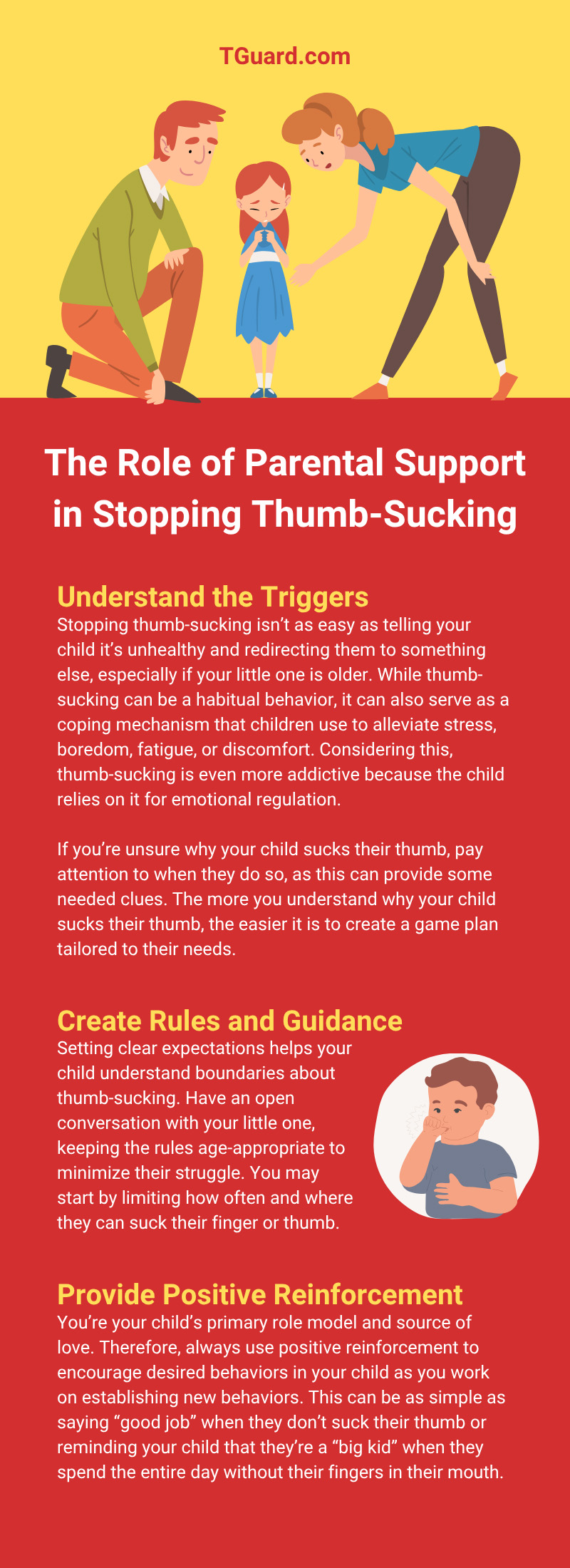As a parent, it’s your responsibility to steer your child away from bad habits so they can grow up into well-adjusted adults. While it often comes from a place of love, this guidance can sometimes mean having tough conversations. Thumb-sucking is a perfect example of this. While sucking on their finger or thumb may bring your child temporary comfort, it can lead to long-term issues, such as dental problems and speech difficulties.
Helping your child break this habit is an essential part of supporting their healthy development. This guide explores the role of parental support in stopping thumb-sucking so you can empower your child.
Understand the Triggers
Stopping thumb-sucking isn’t as easy as telling your child it’s unhealthy and redirecting them to something else, especially if your little one is older. While thumb-sucking can be a habitual behavior, it can also serve as a coping mechanism that children use to alleviate stress, boredom, fatigue, or discomfort. Considering this, thumb-sucking is even more addictive because the child relies on it for emotional regulation.
If you’re unsure why your child sucks their thumb, pay attention to when they do so, as this can provide some needed clues. The more you understand why your child sucks their thumb, the easier it is to create a game plan tailored to their needs.
For instance, if your child sucks their thumb as a stress response when you leave, you may have to treat the separation anxiety before you tackle the thumb-sucking. If the habit is a result of boredom, try to keep your child engaged in an activity when you’re out.
Create Rules and Guidance
Setting clear expectations helps your child understand boundaries about thumb-sucking. Have an open conversation with your little one, keeping the rules age-appropriate to minimize their struggle. You may start by limiting how often and where they can suck their finger or thumb.
For instance, you may allow your child to do it only in the comfort of their own home, not in public or outside the house. This will ensure that they’re aware of when it’s appropriate to engage in the habit. Contact all your child’s caregivers and make them aware of the rules regarding thumb-sucking so you can maintain consistency.
Provide Positive Reinforcement
You’re your child’s primary role model and source of love. Therefore, always use positive reinforcement to encourage desired behaviors in your child as you work on establishing new behaviors. This can be as simple as saying “good job” when they don’t suck their thumb or reminding your child that they’re a “big kid” when they spend the entire day without their fingers in their mouth.
Solely using positive reinforcement helps your child recognize what’s appropriate without harming their self-esteem. Nobody likes feeling shamed, and kids can take it especially hard because they’re still learning to understand our world and emotions. The more ashamed your child feels, the more they may rely on thumb-sucking. If you yell at them or try to scare them into stopping, they might start doing it in secret.
Ideas for Positive Reinforcement
The beautiful thing about positive reinforcement is that it comes in multiple forms that appeal to various people. As you consider incentives, think about what your child likes most and what would be appropriate. Consider rewards such as:
- Stickers or small prizes
- Extra playtime, whether it’s with you or their favorite toy
- A special outing, like a trip to the park or zoo
- Verbal praise and encouragement
- A chart to track progress and milestones
Remember that positive reinforcement must be consistent and done in moderation. Rather than giving your child big rewards for every step of the journey, gradually improve their rewards each time they get closer to breaking the habit.
Offer Alternative Coping Skills
Comfort items can be pivotal for children needing reassurance. Allowing your child to have a consistent, reliable comfort object can ease the transition away from thumb-sucking. As you discourage thumb-sucking, your child may hold plush toys, take deep breaths, or color in a book as a new source of comfort.
By offering other ways to keep your child’s hands busy, you also distract their mind, which gradually decreases the impulsive urge to suck their thumb. Keep in mind that adopting new habits starts with constant reminders and sometimes a bit of trial and error to find the right solution, so patience is key.
Buy Thumb-Sucking Tools
Knowing how to break finger-sucking habits may require using a thumb-sucking glove that slides over their child’s hand. Options such as TGuard’s thumb-sucking glove are comfortable, flexible, and made with medical-grade materials. Your little one can move their hand and fingers normally so they can go about their daily routine, but they won’t be able to comfortably suck on their thumb.
Using a finger or thumb-sucking glove over alternatives like a bitter-tasting solution on the hands creates an element of neutrality. Your child won’t have a negative experience when using the TGuard glove. It gently removes the sensation of suction so your little one naturally gives up the habit because there’s no longer any satisfaction from it.
Foster a Loving Environment
One of the most important roles parental support has in stopping thumb-sucking is in creating a healthy environment for your child. We’re all scared of the unknown, and telling your child to give up the best way they know how to cope with an unpredictable world can create anxiety.
Parents who approach the process with empathy can foster trust and cooperation, helping the child feel understood and less resistant to change. Likewise, taking the time to acknowledge the challenges involved in stopping the habit helps validate your child’s emotions and strengthen the parent-child bond.
Every small step you take to help your child break their finger- or thumb-sucking habit is a testament to your love and care. It’s not about perfection but about being present, patient, and understanding as your child grows through this challenge. Trust that your consistent support can guide them toward confidence and independence, one moment at a time.




